Between 2016 and 2017, Fantasy Flight Games’ business model focused on one-shot board games. This resulted in games such as the Battle of Rokugan and New Angeles with no expansion support. The challenge with this concept is the games need to be vigorously tested and so full of thick content that it could sign a three-season deal with The Learning Channel.
Sadly, Civilization: A New Dawn was met with mixed reactions, and I added my voice to that choir.
Without warning, FFG announced an expansion for this game a few months ago and did their usual sales pitch talking about the extra content. What grabbed everyone’s attention was the various changes to the base game, addressing the numerous concerns the community expressed for the past few years. After playing it a few times, I can say with confidence that this expansion turned an interesting concept into a fully realized experience.
It’s An Upgrade Pack
Although calling this an expansion feels like I am misrepresenting it because it is an upgrade pack in every sense.
One of the most notable changes is civilization-specific focus cards. A major criticism of the original game was the civilization powers taking a backseat to the gameplay experience. With every civilization having their focus card acting as an alternative to the original focus cards, you will now have an extra tool to play with and provides a differential that was absent in the base game.
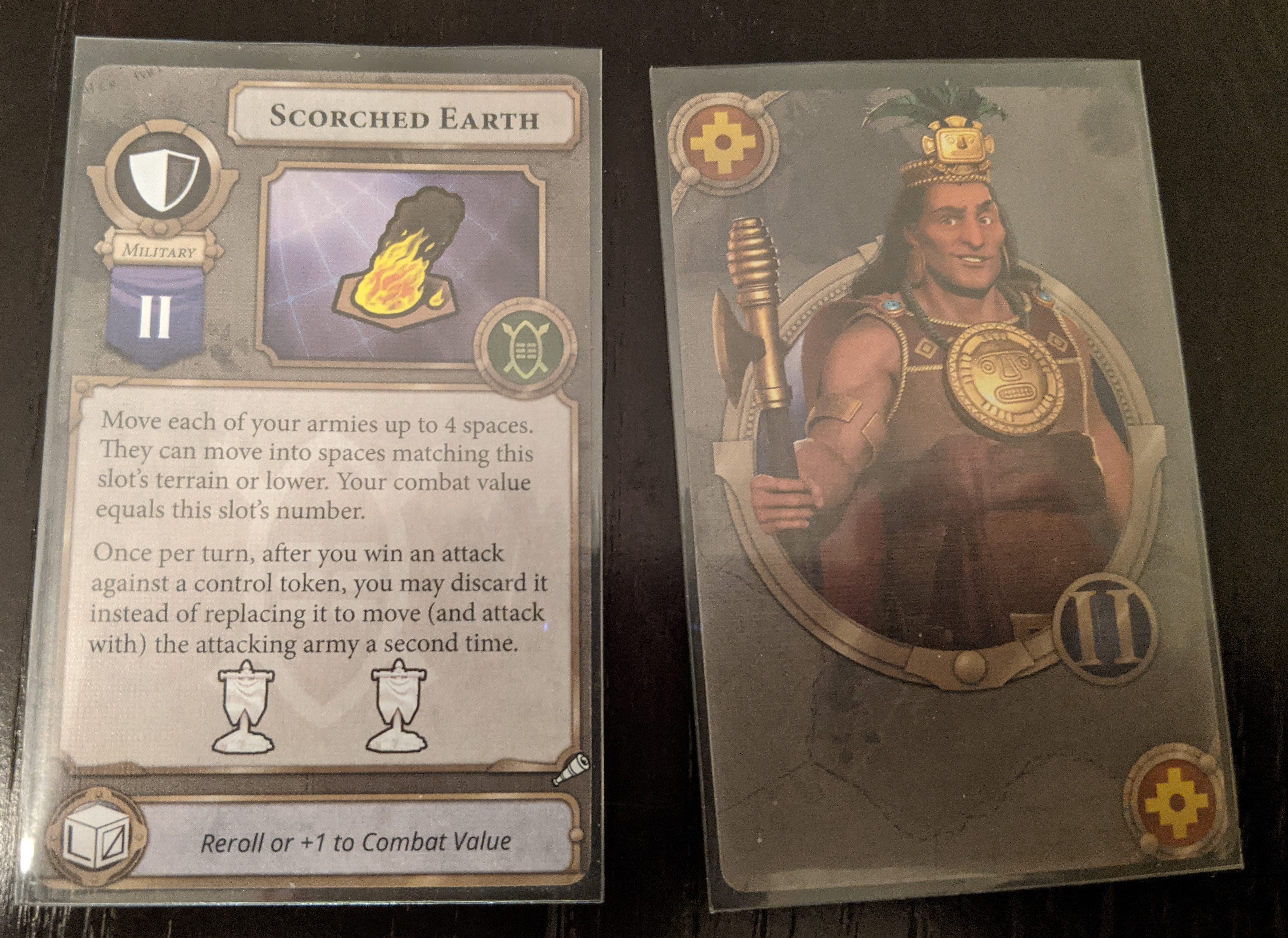
Since we are on the topic of focus cards, you now have six instead of five. Your focus bar now has six slots with the two leftmost slots being 1s. The new card is Growth, giving you the option to place districts and reinforce control tokens. Considering the base game made it challenging to reinforce your tokens, it’s good to see an additional opportunity for a defensive playstyle.
As for the districts, think of them as specialized control markers. There are five different types, each having their own set of conditions and characteristics. Slapping a Campus next to some gorgeous mountains and natural wonders will produce scientific trade tokens. If you are a control freak, a Theater Square helps you place some control markers two spaces away with little concern about terrain difficulty.
My issue with districts lies in the tempo. The base game loved to pound its chest with pride about the quick pace, and it did hit this mark like an Olympian archer. Districts slow down this momentum because you now have to take into consideration the location of these districts by examining the terrain types and the potential output. Furthermore, the new event dial has two specific spots for district activation, so there will be turns where everyone has to do their district actions before using their focus cards.
It would be unfair if I only examined one end of the balance scale. Even though I am not a fan of how districts messed with the flow, I can’t ignore the benefits it brings to the table. These five districts hone in on the five main areas of the game and allow you to cultivate your civilization to a particular strategy, something missing in the base game. Like sending your lovely caravans throughout the world? You can build a Commercial Hub so you can get more trade tokens for each mature city. If you got a barbarian problem, then an Encampment is your answer since they eliminate rival pieces every few turns like some sentient bug zapper.

It Keeps Going
If the specialization stopped right there, I would’ve been fine with that, yet it doesn’t. There is now a government space on the event dial and when it reaches that point, all players will establish a new government. These government tokens boost a card by playing it as if it were further to the right. For example, Democracy gives my research a boost, meaning using a research focus card on the 3rd slot is treated like it was in the 4th slot. This is pretty good so far, but it gets better.
The kicker here is you cannot just pick any government. You must pick a government related to the two “1” slots on your focus bar. Due to this restriction, you are constantly stuck in a crossroad situation as the event dial reaches closer to the government space. Do you use your favored card focus card right now to reset it to the 1 slot to boost it? Or would you rather use it when it reaches your desired apex? It’s a system so simple yet introduces a new way you look at the focus bar.
All of these changes wouldn’t mean much if you can’t expand your empire, and I can finally say that this game has an exploration system. The old way where everyone built a map before the game starts is gone. In its place is the more traditional civilization experience with you exploring beyond your capital tile. As part of the game setup, there will be randomly drawn core tiles that represent the middle of the map, and players will place their capital tiles next to it. This means everyone is within two or three tiles away from each other, allowing the option for the early game aggression that wasn’t possible in the base game. To explore, you need to send a unit to the edge of your capital tile and draw a tile to place it on the map.
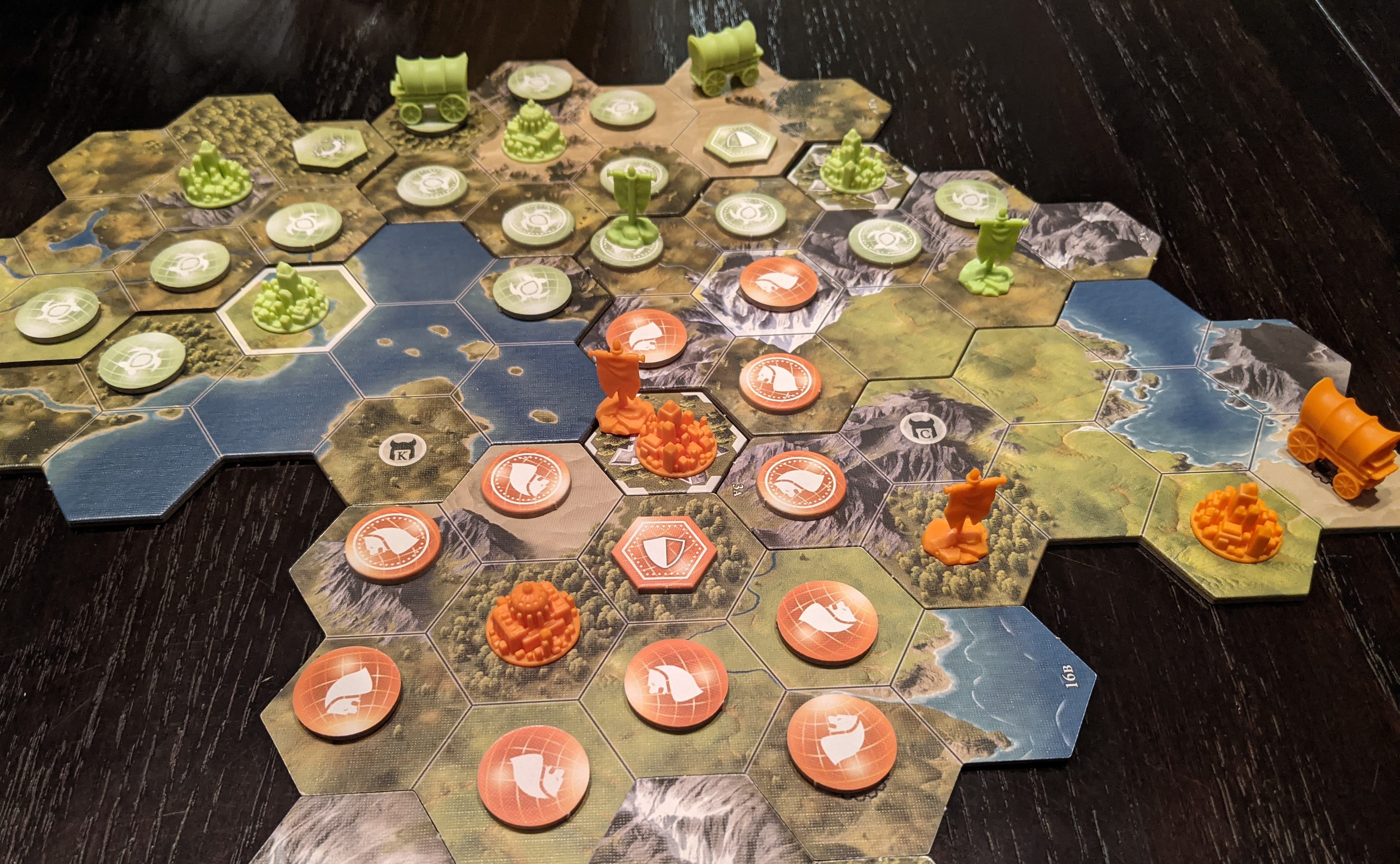
Exploration Is Back
This exploration results in everyone developing their own backyard to play in. You might surround yourself with natural wonders, allowing you to plop world wonders in your cities like flowerbeds in a garden. Or you find yourself in a situation with several city-states of different types, giving you a nice edge of diplomacy cards and trade tokens. Due to this drastic change, it also makes caravans a valuable asset since they can explore the world instead of nabbing trading tokens and diplomacy cards. It also helps that your military attacks are no longer based on control token distance.
Everyone now has a military unit that travels around the board very similar to caravans. They move a specific number of spaces, and the terrain type they can cross is dependent on the slot number. Whenever your military unit runs into a rival piece, they must stop and immediately attack it. The combat itself hasn’t changed and I’m perfectly fine with this. Not every strategy game needs to resolve conflicts with a deterministic system. I can easily point my cynical finger to games like Rising Sun or Scythe as examples of combat systems that are just as alluring as getting crucified to a cactus.
Another benefit of this new system is everyone can see an attack coming and brace themselves for it. No longer are players caught unaware of some stray control token that threatens their entire empire. Being the aggressor in this game requires far more finesse since you need to make sure the terrain is to your advantage and losing a fight as an attacker means you lose the unit. You have to be smart with your strikes, unlike before where there was little punishment for unfavorable battles.
Although attacking other players is helpful in the right conditions, you also have the opportunity to attack forts. Forts are a new piece of territory placed alongside with the capital tiles as part of the game setup. When you move into a fort, you have to win a fight. Your reward for overcoming this fight is a new city and fulfilling one of the goal cards. While I’ll admit this is a nice idea to bring more interaction, but I can’t ignore how silly this is from a thematic standpoint. I don’t recall any civilization famous for simply holding forts.
The victory conditions in this expansion are slightly modified, resulting in military interaction with other players. You have the usual three goal cards as you would expect and two new fort goals. Unlike the three main goal cards, you can lose fort goal cards, and winning the game requires you to complete four out of the five goals. It is still a glorified race similar to the base game, which might be a problem for some of you.
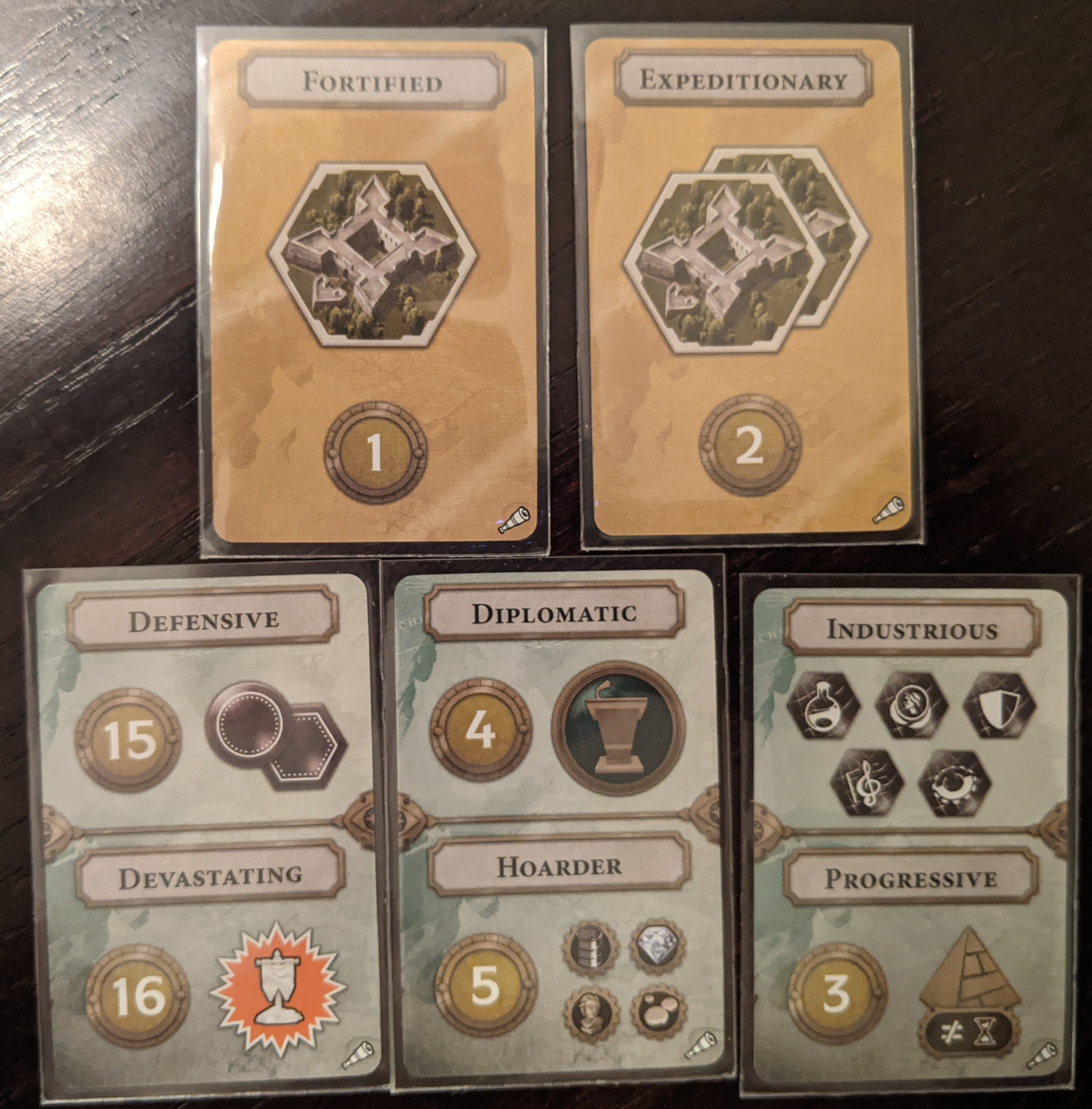
Ending On A High Note
If you made it this far and played the base game, you probably have some questions about the pacing or quality of life. These were also my concerns when I read about the many changes.
For starters, the organization is still a mess. Everything will fit in a single box with sleeved cards, but you will need to discard the crappy cardboard insert to make room for the longer focus bars. Most of the components replace the base game components, with the only major drawback being the new fifth player components.
The pacing is slowed down but not as much as I feared. Playing the game for the first time with three people took about two hours and we didn’t even know two hours passed because we were so engaged with the experience. The only moments that made us pause were the government and district events, which took as much time as the barbarian movement once we were accustomed to it.
The rulebook, in typical FFG style, is going to make this a hurdle to understand. You will need to unlearn the core basics and internalize the new reforms. Do expect your first one or two games to involve rifling through the rulebook. Oddly enough, I would use the expansion when teaching brand new players. Since the map starts small, you can talk about the map features such as natural wonders or city-states as they expose themselves throughout the game. No longer are new players subjected to a huge intimidating map, and you don’t need to barf out sentences to explain every detail in one go like some insomnia curing classroom lecture.
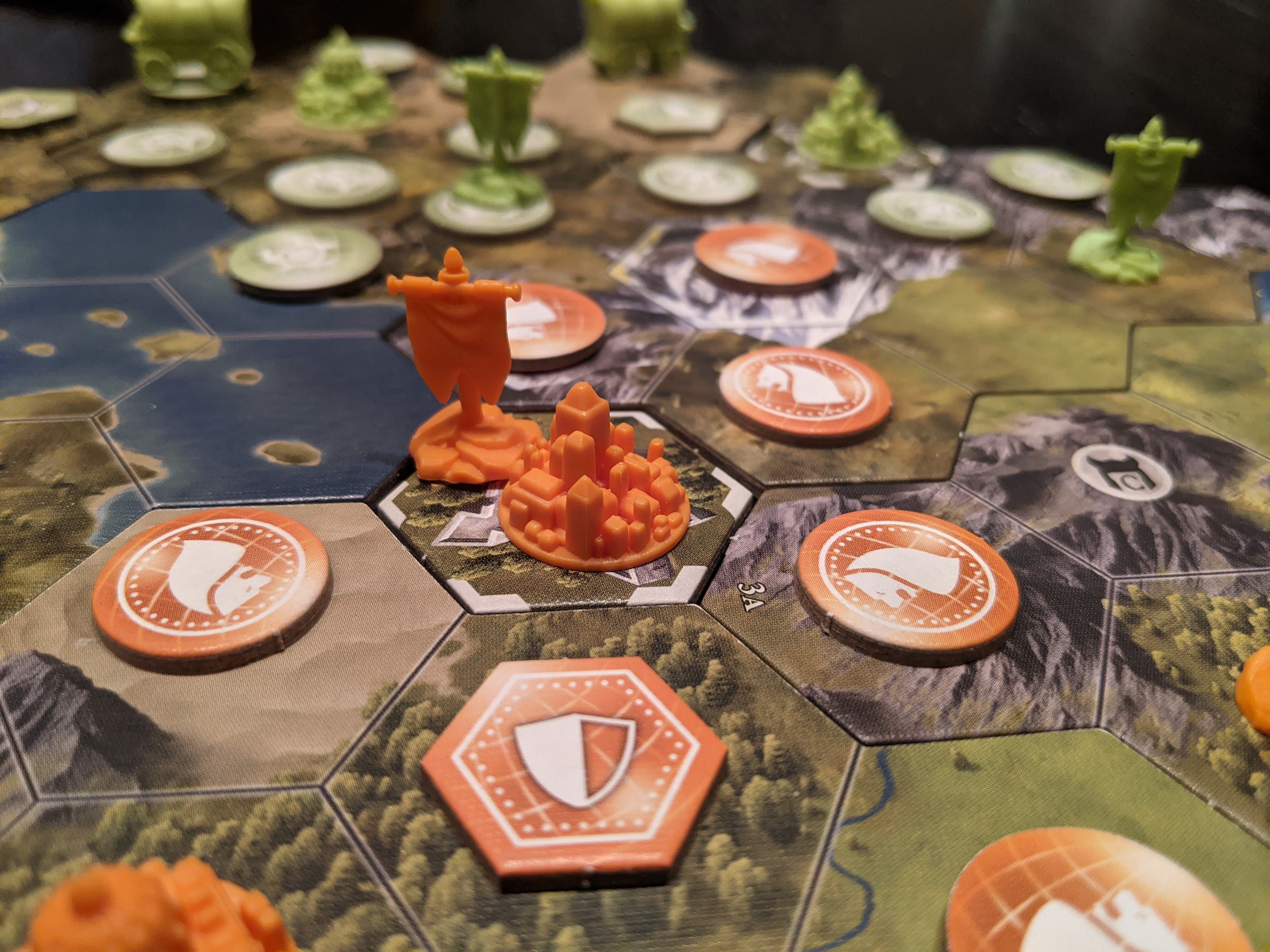
It is not every day we see an expansion that revitalizes the original structure of the game. I will even go so far as to say I find most expansions to suffocate the experience through fluff content. Very few expansions ascend the core game to a whole new level. The only two on top of my head would be Lords of Waterdeep‘s Scoundrels of Skullport and Viticulture’s Tuscany.
Compared to other civilization games, this is still a weird abstract that defies the tropes of the genre. People heavily criticized the base game for cutting out expectations such as exploration or specialization. Terra Incognita reintroduces these traditions with a well-executed twist, giving the game its own identity and purpose. It will likely not attract the boomer crowd who are still captivated with 80s game design or those seeking the emulation of the computer game like the 2010 Civilization board game. For those of us outside of those circles that want a bite out of this genre, you can’t go wrong with this one.
Buy Civilization Terra Incognita on Amazon US


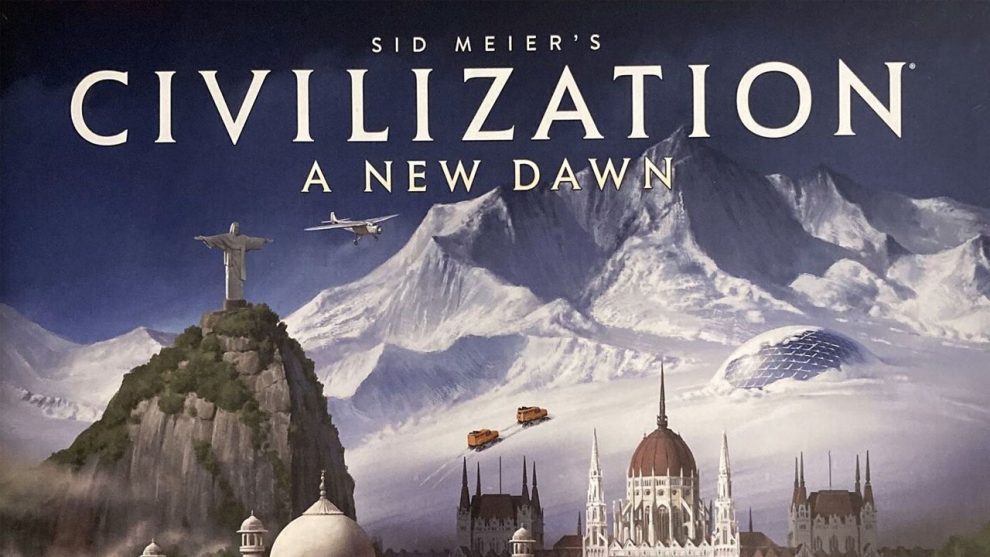








Great review. I’ve have the base game for a year and it never clicked with my group. They found it very dry and most of the time we are a group of 5, so bringing this to the table was a challenge already. Going to give this a go after reading this review, seems like a lot of my groups complaints have been fixed.
Link them to this review and have them check it out themselves 😉